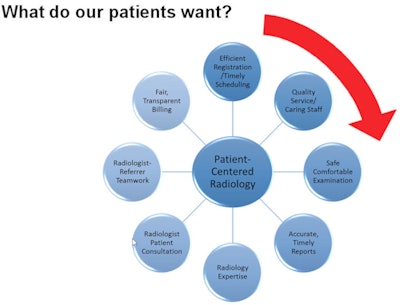
SAN FRANCISCO - Gauging the value of a CT scan is the single most critical reason for deciding whether to perform an exam. But when you get down to it, value depends on what you're looking for and who's looking at it, according to talks on Sunday at the International Society for Computed Tomography (ISCT) annual meeting.
To Dr. H. Benjamin Harvey from Massachusetts General Hospital (MGH), what matters to the patient isn't always what the provider or payor might think is important.
To Dr. Geoffrey Rubin, ISCT course director and chair of radiology at Duke University Medical Center, answering the key question of why we scan with CT depends on who is asking the question.
Many perspectives
"Depending on our perspective, we might have different reasons" for a CT scan, Rubin said. The economic explanation would be that it creates value for someone. The altruistic explanation would be that it supports a patient's diagnosis and treatment.
 Dr. Geoffrey Rubin from Duke University.
Dr. Geoffrey Rubin from Duke University."And if we're running a business, it's because it pays," he said. "That's the pragmatic explanation."
But it's the perspective of the person experiencing the value that ultimately will generate it, and each stakeholder realizes different values, Rubin said. Creating value in CT imaging begins with understanding the different perspectives:
- Patients seek high-quality medical care from highly trained providers, as well as a more active role in decision-making and payments. They rely on medical providers as technical experts to help them understand their options, risks, and costs. They are increasingly asked to rate their satisfaction in surveys.
- Providers and referring providers want to provide high-quality care in a safe environment. They're challenged with increasingly heavy workloads and a confusing, rapidly changing reimbursement environment. They need innovative equipment and information technology to deliver value, but the challenges vary by specialty and health system.
- Payors face risk spread across large populations. They must balance revenue with expenditures to be sustainable. They seek reliable cost scenarios and cost-effectiveness data. They need high-quality risk-benefit scenarios to evaluate alternative programs, procedures, and interventions.
- Health systems operate capital- and labor-intensive businesses in a highly competitive and regulated environment. They must compete with patients and groups of patients through employer relationships with other health systems. They must engage physicians, who are independent actors, to manage care. They have little utilization control in hospitalized patients. The analytics they need are often underresourced.
- Societies must design health systems to serve the needs of countries, with sustainability as a key concern. They must reconcile the different perspectives of subpopulations and special-interest groups regarding the provision of health services. They must comply with policies developed by elected officials who often lack knowledge of healthcare and are subject to lobbying by special interests.
A look at the value from different stakeholders reveals "just how different those values are," Rubin said. Value can be readily schematized through equations, but it remains extremely variable.
"Radiology providers need to understand the unique perspectives of key stakeholders when valuing technology such as CT," he said. "Stakeholder-focused positioning of investment proposals is an important strategy for obtaining organizational support."
What the patient wants
Defining quality in the CT value equation isn't as simple as radiologists doing a good job, according to Harvey, who is director of radiology quality improvement at MGH. It's the patient experience that matters -- how good a job the patient thinks you did. That's why Harvey calculates value as outcomes plus the patient experience over costs and indirect costs.
 Dr. H. Benjamin Harvey from MGH.
Dr. H. Benjamin Harvey from MGH."How the patient feels their imaging experience went is as important as how it actually went," he said. The quality of the patient CT imaging experience turns out to depend largely on this perception.
"I think in recent years the quality and safety literature have pushed us too far toward process and toward getting outcomes, which bound our hands," Harvey said. Simple "process compliance ... does not equal quality, and it does not equal value." How that process was received and the outcomes that emerge from that process are much more important.
"To define quality in the CT value chain, we must step into the shoes of our customers," he said. "In the quality and safety space, we've overcomplicated things that aren't that complicated."
So step into the shoes of your patients, as well as those of health systems and hospitals, he added. And what do patients really want?
"If I were a patient, I'd love to be able to choose my own appointment time," he said. "I'd love to not have to fill out silly paperwork every time. Maybe I could do it quickly on my phone. I'd love the fact that if you already had that information, I didn't have to write my address again. I want an easy intake. I want to know that the person at the front desk cares about me -- I want that to be a good experience. I want the parking to be convenient. We think it's silly, but when you spend 30 minutes driving around looking for a parking space for your CT exam, it shapes and reflects on how you think about that experience."
 What the patient wants consists almost entirely of the customer experience: ease of registration, ease of exam, timeliness, and accuracy of reporting and billing. Image courtesy of Dr. H. Benjamin Harvey.
What the patient wants consists almost entirely of the customer experience: ease of registration, ease of exam, timeliness, and accuracy of reporting and billing. Image courtesy of Dr. H. Benjamin Harvey.Patients want a comfortable exam, and they want reports to be accurate and timely. The reason that so few factors -- the efficiency of registration and intake, the comfort of the exam, and the timeliness of communications -- matter so much is because "the vast majority of patients ... don't know what a good radiology report is," Harvey said. "So a lot of the radiology experience is shaped according to what they're used to perceiving: a customer service experience."
Patients do want radiologists to talk to the referring physicians so the "right hand knows what the left hand is doing," Harvey said, and they want fair and transparent billing. One study showed that 80% of hospital bills had gross overcharges or mistakes.
"We often forget that many of our patients are paying an entire week's wage to get the study that we are reading," he said.
"If we can hone our CT operations in order to meet the needs of those customers, our numerator in the value equation will be where it needs to be for us to have a successful future," Harvey said.




















